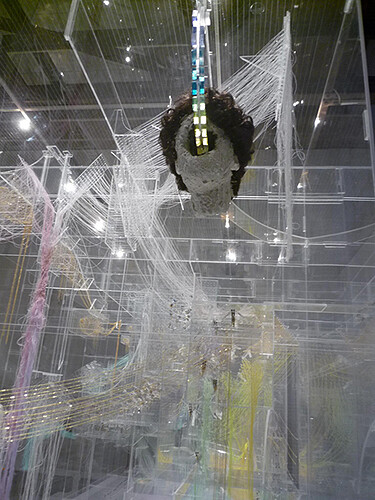“Property itself has become a more social endeavor,” Wired Magazine co-founder Kevin Kelly wrote three years ago. The now famed blog post describes the dematerialization of raw materials and other saleable objects as a social phenomenon, citing shared music, books, and movies, as among the goods on their way out. Instead, they will all be part of “the cloud,” a vast digital network accessible via tax or subscription.
It’s hard not to think about this concept at David Altmejd’s current exhibition at Andrea Rosen—a visual interpretation of the decentralization and dematerialization we are currently witnessing. Nearly every figurative sculpture and vitrine in the show suggests dispersion, a mass of complicated networks and slow decomposition of substance. This result isn’t always particularly compelling or resolved—Altmejd too frequently fails to account for the viewer’s experience—but the show has a few highlights regardless.
Even from the gallery’s entrance we are told the show is about the freedoms afforded by re-distribution and re-constitution. A winged figurative sculpture made of plaster graces gallery’s entrance, apparently fashioned from the materials in the gallery walls. Altmejd’s transformation of materials is so complete it’s impossible to know this without reading the press release, but it’s clear the wall dirt, unencumbered its traditional form is now ready to fly.
This is a fine idea, but the sculpture itself is the argument for freeing nature of material transformation and it fails to make one. It’s simply an inert figure in white.
This is a shaky beginning, but the show starts to look up about three steps into the actual space. Two giant Plexiglas vitrines occupy the main gallery. The first, The Vessel (2011), is a marvel of symmetry, evoking the human nervous system. Various parts of the front end including shelves and hands mostly resemble a swan, while the back-end looks like a brain. Thread is wound everywhere as if the psychedelic center of a Michaels Craft Store.
There probably isn’t more going on in this vitrine past communicating the notion of a dematerialized body and a nervous system gone nervous, and that’s fine. The forms take on a delicate grace, which appear freed of their corporal forms.
The vitrine, however, is a failure. It too is transforming itself—small parts of the casing are broken and integrated into the work—but because the metamorphosis isn’t very far along the piece often looks sloppy. Globs of glue affixing various materials and seams of the Plexiglass may represent the first stages of change but they are also too easily mistaken for artistic contrivance.
This is no less true of the second vitrine-encased piece, The Swarm (2011) that looks like it could have used another month in the studio. Unlike the first, there is no central focus. The gallery-sized box is filled with swarms of Plexiglas winged bees, pairs of plaster ears joined to look like butterfly wings, and jellyfish made from thread. On a nearby wall, a line of plaster ears looks as though it were started and forgotten, as does a small line of eight holes at the base of the wall with no apparent purpose. While I get that these holes may be part of the metamorphosis, and that this vitrine is even further along in its dematerialization and decentralization process, I don’t like that viewer remains largely outside this transformation. Networks of any sort don’t work without interactivity, yet this one is almost wholly lacking anything of the sort.
A series of formed plaster figures emerging from the gallery’s drywall makes the most obvious connection to transformed materials, but they are also the works I feel most uncertain about. The angel hanging over the main gallery looks as though it’s directly inspired by stock motorcycle gang logos, and in the back room, another modeled figure hangs above a vitrine housing a bunch of minerals. In this one, the plaster hands that give shape to a figure rising from the wall mimic feathers the same fingers have clawed out of the space. Here, the power and energy within this form freed of its material being is clear, a success seen in stark contrast to the still birth, in the front gallery. Unfortunately, some of this brilliance is offset by a giant hole the artist put in the wall that throws off the composition.
As for Altmejd’s backroom rare-rock vitrine, it’s important for being the only stock of raw materials in the show, but is still given slightly more prominence than necessary. Were this a Kelly lecture, the stones would be allotted a 30 second time slot in the introduction of a 45-minute talk. In this show, Altmejd dedicates the majority of a secondary space, to a vitrine that underscores the self-evident.






